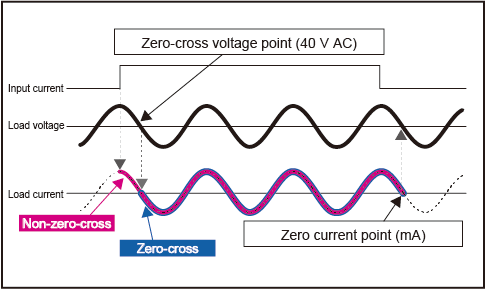We are going to focus on the zero-cross function of the solid-state replay (SSR), based on some customer’s inquiries. If you have similar questions, please find the solutions through this article.
Question:
The SSRs include zero-cross types and non-zero-cross types. What is the difference between these two types?
Answer:
The zero-cross type SSR switches on when the load voltage is close to zero volts. Therefore it has the advantage of less noise generation when switching operation (switching on). In contrast, the non-zero-cross type SSR switches on regardless of whether the load voltage is close to zero volts or not. It is operation time short, and use it to be available for phase control.
The SSR has a relay performance, it is between input and output are insulated by a phototriac coupler, etc.
The zero-cross type SSR has a built-in zero-cross circuit, it’s switch on at close to a zero-voltage point of alternating current even if a signal is input to the SSR at not close to the zero-voltage point. In this manner, this type of SSR switches on at a point of time at which voltage stays low, thus suppressing the occurrence of switching noise or inrush current. Also,this SSR does not switch off immediately when the incoming signal goes low, and switches off at a point of time at which a load current reduces to almost zero.

The non-zero-cross type SSR, on the other hand, switches on immediately when the incoming signal goes high. When the incoming signal goes low, however, it switches off at a point of time at which the load current reduces to almost zero, as same as the zero-cross type SSR. Having this characteristic, this type of SSR can be used in a control method (phase control). Meaning that the SSR can be switched on by an incoming pulse signal with the proper phase timing, allowing operations such as a heater or motor to change its calorific value or rotating speed.
This article explained two types of SSRs – "zero-cross" and "non-zero-cross." In general, the zero-cross type SSR is widely used in many applications. We would like you to know nevertheless that the non-zero-cross type SSR is also used effectively to control such circuit loads as a heater or motor. We believe what you've obtained from this information will help you design various circuits.
Keywords
- SSR: SSR stands for Solid State Relay. It is a contactless relay composed of a light-emitting semiconductor, i.e., LED, that serves as an input end, and a semiconductor, such as transistor and triac, that serves as an output end. The SSR responses faster than a contact relay.
- Load: A load is connected to the output end of a circuit, and consumes electric energy in the circuit.
- Inrush current: Inrush current refers to a large current that instantaneously flows through the circuit when the power supply is turned on.
- Triac: This is a semiconductor switching element with three terminals for use in AC circuits. Applying a signal to its gate terminal allows current to flow between the other two terminals in both directions.
- Pulse signal: A pulse signal changes voltage level in short time intervals. Some pulse signals change voltage level cyclically at regular time intervals, while other pulse signals change at irregular time intervals.





